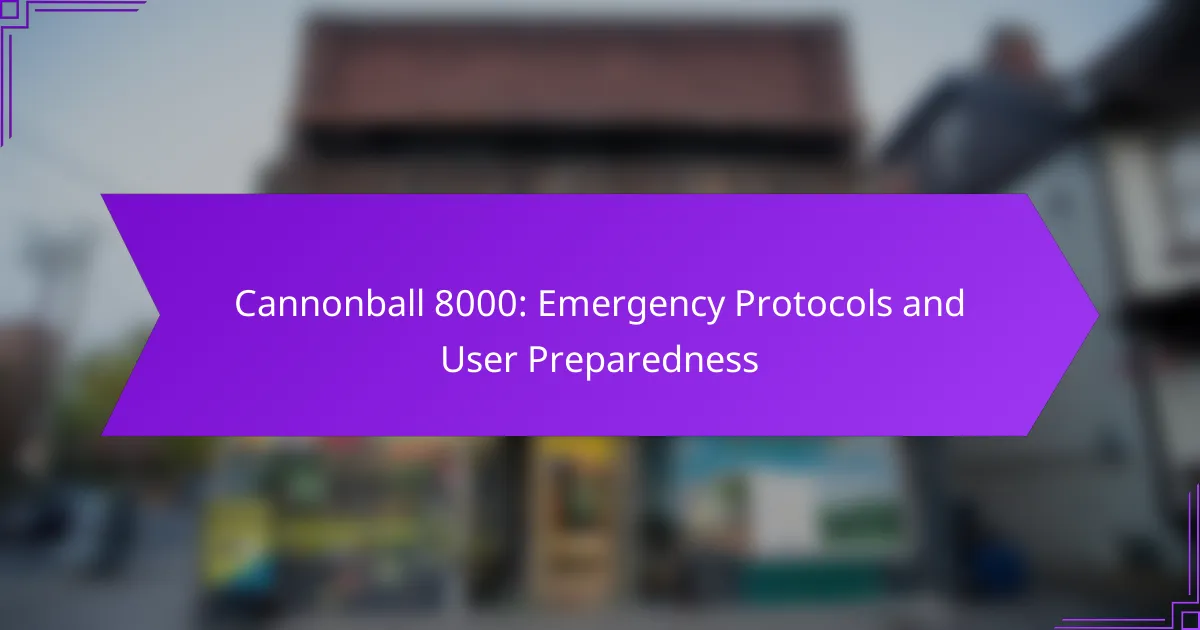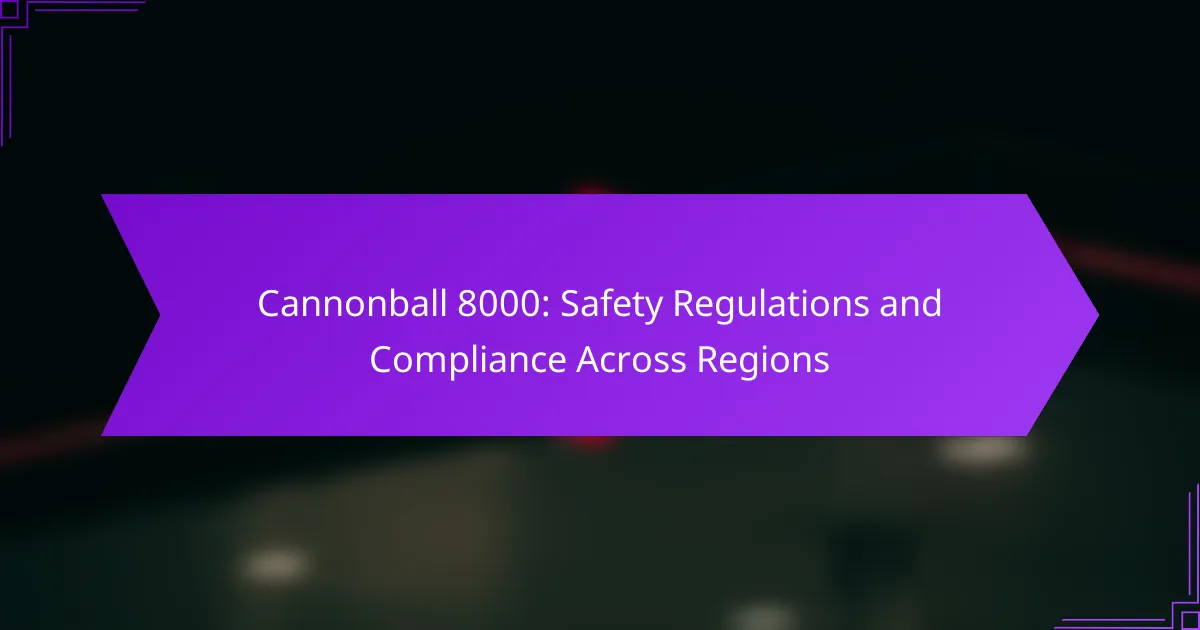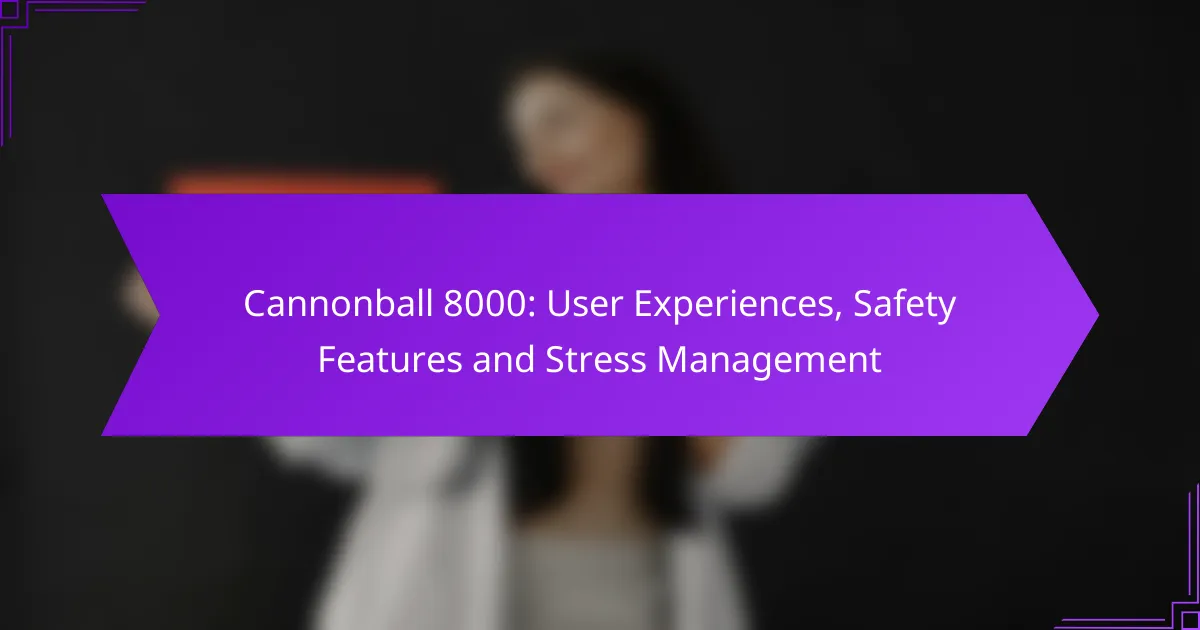The Cannonball 8000 is equipped with essential features that enhance user preparedness during emergencies, including real-time monitoring and automated alerts. To ensure safety and effective responses in critical situations, users must adhere to specific emergency protocols, such as evacuation procedures and communication with emergency services. Regular training and participation in emergency drills are crucial for familiarizing users with the equipment and maintaining a safety equipment checklist.
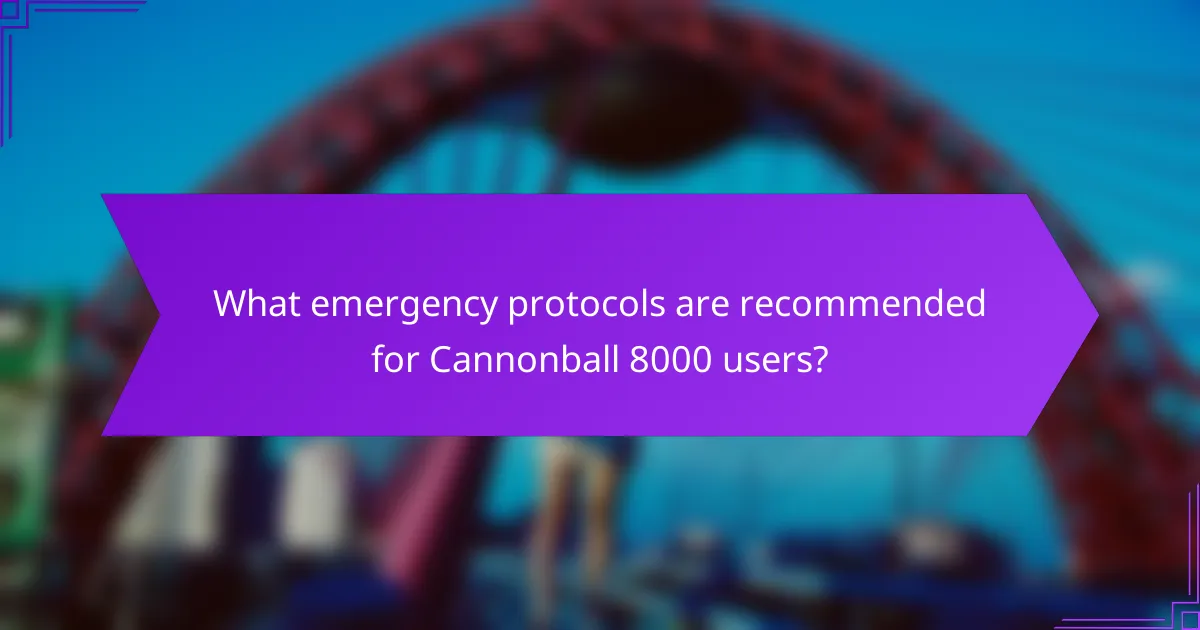
What emergency protocols are recommended for Cannonball 8000 users?
Cannonball 8000 users should follow specific emergency protocols to ensure safety and effective response during critical situations. These protocols include immediate evacuation procedures, communication with emergency services, and maintaining a safety equipment checklist.
Immediate evacuation procedures
In the event of an emergency, users should prioritize a swift evacuation from the Cannonball 8000. Familiarize yourself with all exit routes and ensure they are unobstructed. Practice evacuation drills regularly to reinforce quick decision-making under pressure.
During an evacuation, remain calm and guide others to follow you. Use emergency lighting if available, and avoid using elevators. Aim to exit the area within a few minutes to minimize risks.
Communication protocols with emergency services
Establish clear communication protocols with local emergency services to ensure timely assistance. Users should have emergency contact numbers readily available, including local fire, police, and medical services. Keep a charged mobile device on hand for immediate communication.
When contacting emergency services, provide concise information about the situation, including your location and the nature of the emergency. Follow their instructions carefully and stay on the line until help arrives.
Safety equipment checklist
Maintaining a safety equipment checklist is crucial for Cannonball 8000 users to prepare for emergencies. Essential items include a first aid kit, fire extinguisher, flashlight, and extra batteries. Regularly inspect and replenish supplies to ensure readiness.
- First aid kit
- Fire extinguisher
- Flashlight with batteries
- Emergency contact list
- Whistle for signaling
Review this checklist periodically and ensure all users are familiar with the location and use of safety equipment. This preparedness can significantly enhance safety during emergencies.
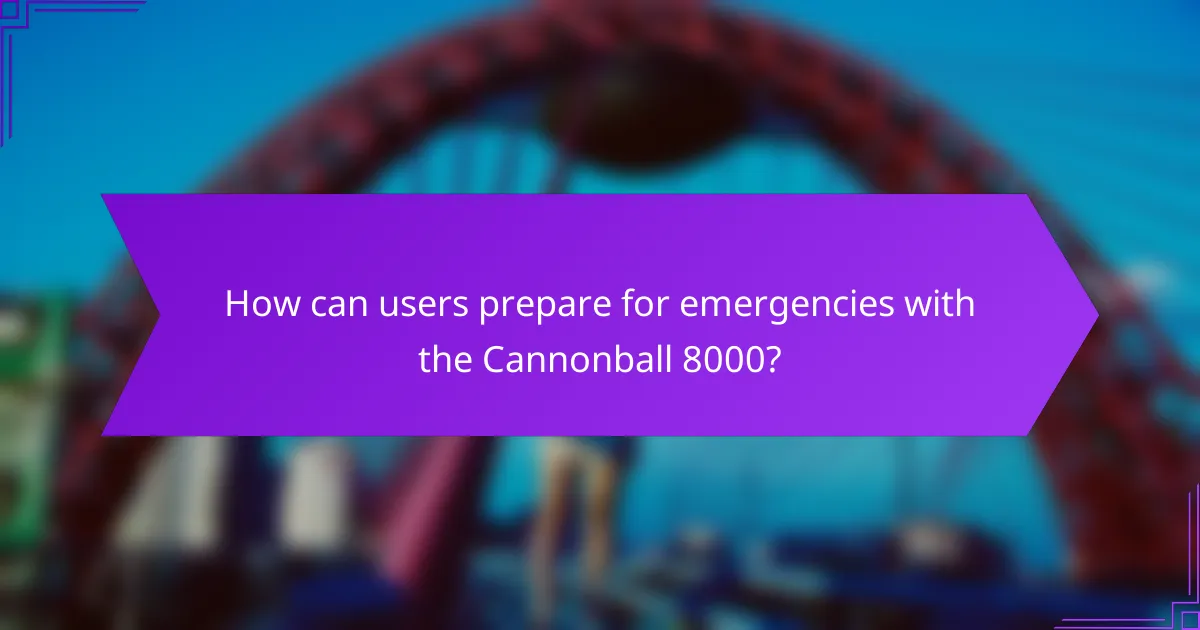
How can users prepare for emergencies with the Cannonball 8000?
Users can prepare for emergencies with the Cannonball 8000 by engaging in regular training, participating in scheduled emergency drills, and equipping themselves with appropriate personal safety gear. These steps ensure that users are familiar with the equipment and can respond effectively in critical situations.
Regular training sessions
Regular training sessions are essential for users to become proficient with the Cannonball 8000. These sessions should cover operational procedures, emergency protocols, and troubleshooting techniques. Aim for at least monthly training to maintain skills and confidence.
Consider incorporating scenario-based training that simulates potential emergencies. This hands-on approach helps users practice their responses in a controlled environment, reinforcing their ability to act quickly and effectively when real situations arise.
Emergency drills schedule
Establishing a clear emergency drills schedule is crucial for preparedness. Drills should occur at least quarterly, allowing users to practice their roles and responsibilities during an emergency. Consistency helps reinforce the knowledge and skills gained during training sessions.
During these drills, evaluate the effectiveness of the response and identify areas for improvement. Adjust the schedule based on feedback and any changes in operational procedures or equipment to ensure ongoing readiness.
Personal safety gear recommendations
Equipping users with the right personal safety gear is vital for emergency preparedness with the Cannonball 8000. Recommended gear includes helmets, gloves, and protective eyewear, which can help prevent injuries during emergencies. Ensure that all gear meets relevant safety standards.
Additionally, consider providing communication devices, such as two-way radios, to facilitate coordination during emergencies. Regularly inspect and maintain this gear to ensure it is in good working condition and ready for use when needed.

What are the key features of Cannonball 8000 for emergency situations?
The Cannonball 8000 is designed with several critical features that enhance user preparedness during emergencies. Its capabilities include real-time monitoring, automated alerts, and robust durability, ensuring reliable performance in high-stress scenarios.
Real-time monitoring capabilities
The Cannonball 8000 offers real-time monitoring of various environmental parameters, such as temperature, humidity, and air quality. This feature allows users to receive immediate updates on conditions that could affect safety, enabling timely decision-making.
Users can customize monitoring thresholds to suit specific needs, ensuring alerts are triggered when conditions exceed safe limits. This proactive approach helps in preventing emergencies before they escalate.
Automated alert systems
The automated alert systems of the Cannonball 8000 are designed to notify users instantly via multiple channels, including SMS, email, and app notifications. This ensures that critical information reaches users regardless of their location.
Alerts can be configured based on user preferences, allowing for tailored notifications that focus on the most relevant data. This customization enhances user responsiveness during emergencies.
Durability in extreme conditions
Built to withstand extreme conditions, the Cannonball 8000 is resistant to water, dust, and temperature fluctuations. Its rugged design ensures that it remains operational in harsh environments, making it suitable for outdoor and industrial applications.
Users should consider the device’s IP rating and operational temperature range when deploying it in challenging settings. This durability ensures reliability when it matters most, reducing the risk of equipment failure during emergencies.

What are the best practices for maintaining the Cannonball 8000?
Maintaining the Cannonball 8000 involves adhering to a structured routine that ensures optimal performance and longevity. Regular checks and cleaning, along with timely replacement of parts, are essential to prevent malfunctions and ensure safety.
Regular maintenance schedule
Establish a regular maintenance schedule for the Cannonball 8000 to keep it in peak condition. A monthly inspection is recommended, focusing on key components such as the power supply, safety features, and overall functionality.
During these inspections, check for any signs of wear or damage. Keeping a log of maintenance activities can help track performance and identify any recurring issues that may need addressing.
Recommended cleaning procedures
Cleaning the Cannonball 8000 is crucial for its performance. Use a soft, damp cloth to wipe down the exterior and avoid abrasive materials that could scratch surfaces. Ensure that all vents and openings are free from dust and debris.
Internally, follow the manufacturer’s guidelines for cleaning components. Regularly remove any buildup that could obstruct airflow or cause overheating, typically every few months, depending on usage.
Replacement part guidelines
When it comes to replacement parts for the Cannonball 8000, always use manufacturer-approved components to ensure compatibility and safety. Keep a stock of essential parts, such as filters and fuses, to minimize downtime during repairs.
Monitor the condition of parts regularly and replace them at the first sign of deterioration. This proactive approach can prevent more significant issues and extend the overall lifespan of the device.

What training resources are available for Cannonball 8000 users?
Cannonball 8000 users have access to a variety of training resources designed to enhance their understanding and preparedness for emergency protocols. These resources include online training modules, in-person workshops, and comprehensive user manuals, each catering to different learning preferences and needs.
Online training modules
Online training modules provide a flexible way for users to learn about the Cannonball 8000’s emergency protocols at their own pace. These modules typically include video tutorials, interactive quizzes, and downloadable resources that cover essential topics such as system operation and emergency response procedures.
Users can expect to spend anywhere from a few hours to a couple of days completing these modules, depending on the depth of content. Many platforms also offer certification upon completion, which can be beneficial for professional development.
In-person workshops
In-person workshops offer a hands-on approach to learning about the Cannonball 8000. These sessions are typically led by experienced trainers and provide opportunities for users to engage in practical exercises and simulations of emergency scenarios.
Workshops usually last one to two days and are often held at designated training centers or company facilities. Participants can benefit from direct interaction with instructors and peers, allowing for real-time feedback and discussion.
User manuals and documentation
User manuals and documentation serve as essential reference materials for Cannonball 8000 users. These documents typically include detailed instructions on system setup, operation, and troubleshooting, as well as emergency protocols that users must follow.
It’s advisable for users to familiarize themselves with these manuals before emergencies arise. Keeping a printed copy accessible and ensuring that all team members know how to locate and utilize these resources can significantly enhance preparedness during critical situations.

How do local regulations impact Cannonball 8000 usage?
Local regulations significantly influence the usage of the Cannonball 8000 by establishing safety standards and operational protocols. Compliance with these regulations ensures that users can operate the device effectively while minimizing risks to themselves and others.
Compliance with safety standards
Compliance with safety standards is crucial for the Cannonball 8000, as it dictates how the device should be used in various environments. Users should familiarize themselves with local safety regulations, which may include guidelines on equipment maintenance, operational limits, and user training requirements.
For example, in many regions, the Cannonball 8000 must meet specific electrical safety standards to prevent hazards. Users should verify that their device is certified according to local regulations, which can vary widely between countries.
Local emergency response integration
Integrating the Cannonball 8000 with local emergency response protocols enhances its effectiveness during critical situations. Users should coordinate with local authorities to ensure that the device can be utilized in emergencies, such as natural disasters or public safety incidents.
For instance, some areas may require users to notify emergency services when deploying the Cannonball 8000, allowing for better resource allocation and response times. Establishing communication channels with local responders can significantly improve outcomes during emergencies.
